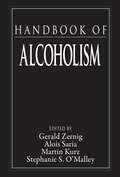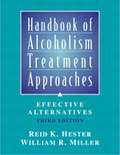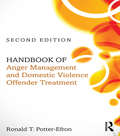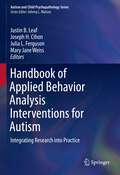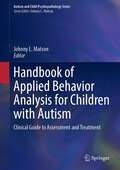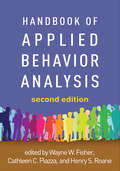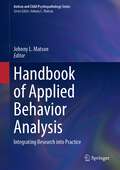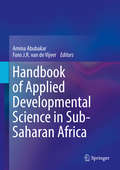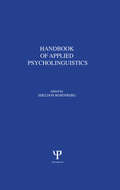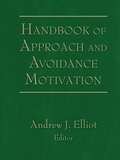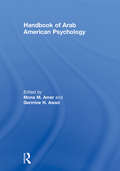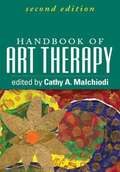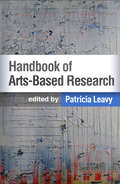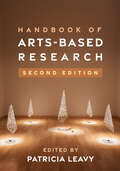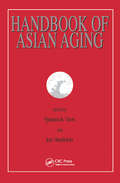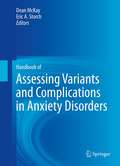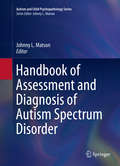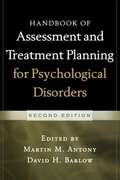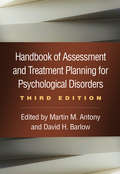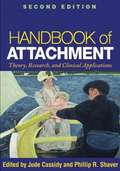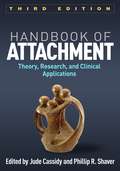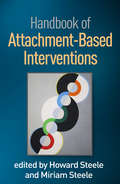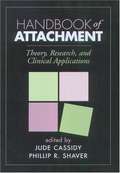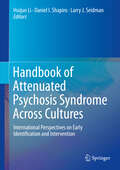- Table View
- List View
Handbook of Alcoholism (Handbooks in Pharmacology and Toxicology)
by Gerald Zernig Alois Saria Martin Kurz Stephanie S. O’MalleyWhile the war on drugs continues to attract world attention, it is often overlooked that alcoholism remains a major worldwide health concern. No matter what your expertise, the CRC Handbook of Alcoholism can help you acquire the necessary skills to treat problem drinkers and alcohol-dependent patients.In three sections - Patient Care, Research,
Handbook of Alcoholism Treatment Approaches: Effective Alternatives, Third Edition
by William R. Miller Reid K. HesterThe Handbook of Alcoholism Treatment Approaches is a comprehensive, results-based guide to alcohol treatment methods. This handbook surveys the various models that have been used to define alcoholism, ending with a discussion of what the authors call "an informed eclecticism. " Using this approach, clinicians develop a spectrum of treatment approaches that have proved effective in practice, then match specific clients with the treatment methods that offer the greatest opportunities for success in these specific circumstances. This new edition of this handy reference provides both practitioners and researchers with a rich source of information on treatment interventions demonstrated to be the most successful. Clinical Psychologists and Alcohol Treatment Specialists.
Handbook of Anger Management and Domestic Violence Offender Treatment
by Ron Potter-EfronRonald T. Potter-Efron consciously connects anger management and domestic violence, two long separated fields, and addresses treatment options and intervention methods that meet the needs of individual clients, couples, families, and groups. Therapists, counselors, social workers, and other treatment specialists will find this book a useful overview and reference for anger and anger management techniques as well as domestic violence approaches. This new edition is split into four distinct sections:• A description of anger and domestic violence focused upon helping clients use the principles of neuroplasticity to dramatically alter their behavior• Assessment for anger problems and/or domestic violence• Group treatment for individuals with anger problems and/or domestic violence• Individual, couples, and family treatment of these concerns. Woven through this book is a fair and balanced treatment of gender issues, reflected in the diversity of case examples that address jealousy, chronic anger, behavioral problems, group and individual counseling, and more. Readers are also shown how anger develops and can lead to verbal and physical outbursts, the five types of rage reactions, and how to treat anger turned inward. Potter-Efron also details four different approaches to treating anger: behavioral, cognitive, affective, and existential/spiritual. Mental health professionals are provided numerous questionnaires and worksheets to utilize with their clients. Handbook of Anger Management and Domestic Violence Offender Treatment is an essential guidebook that illustrates effective theory and practice.
Handbook of Anger, Aggression, and Violence
by Victor R. Preedy Colin R. Martin Vinood B. PatelThis handbook provides a detailed overview of the emotional, physical, and social implications of anger, aggression, and violence. The book covers the recognition, diagnosis, and evaluation of these areas, aiming to understand the aetiology of these behavioral features to assist with prevention and cure. The book is divided into eight sections: Placing Aggression, Anger, Aggression and Violence In ContextCauses and Precipitation of Anger, Aggression and ViolenceFeatures of Anger, Aggression and ViolenceAnger, Aggression and Violence in Defined Disorders and ConditionsPhysical Measures of Pathology and Insights: GeneticsPhysical Measures of Pathology and Insights: Non-GeneticTreatments and TherapiesMethods and Techniques Handbook of Anger, Aggression, and Violence will be of use for behavioral scientists, psychologists, psychiatric nurses and doctors, neurologists, health scientists, general practitioners, research scientists and all those interested in altered behavior.
Handbook of Applied Behavior Analysis Interventions for Autism: Integrating Research into Practice (Autism and Child Psychopathology Series)
by Justin B. Leaf Mary Jane Weiss Joseph H. Cihon Julia L. FergusonThis handbook addresses evidence-based practices in Applied Behavior Analysis (ABA) for individuals diagnosed with autism spectrum disorder (ASD). It provides an overview of the history of evidence-based practices and their importance as applied to the law, school settings, and factors that influence the use for treatment of ASD. Additional areas of coverage include evidence-based and non-evidence-based ABA interventions for autism as well as decision-making ethics related to these treatments. In addition, the book addresses cultural considerations as they relate to these treatments and examines procedural aspects of ABA interventions for autism. Key ABA treatments addressed include: Discrete trial teaching. Pivotal response training. Video modeling. Parent-mediated intervention. Early Start Denver Model, PEAK, PECS, and AAC. Script fading/activity schedules and differential reinforcement/extinction. Response interruption and redirection. Self-management and self-monitoring. The Handbook of Applied Behavior Analysis Interventions for Autism is a must-have resource for researchers, professors, and graduate students as well as clinicians, therapists, and other professionals across such interrelated disciplines as clinical child, school, and developmental psychology, child and adolescent psychiatry, social work, rehabilitation medicine/therapy, pediatrics, and special education.
Handbook of Applied Behavior Analysis for Children with Autism: Clinical Guide to Assessment and Treatment (Autism and Child Psychopathology Series)
by Johnny L. MatsonThe handbook examines the latest advancements in applied behavior analysis (ABA) as the preferred method of treatment for children diagnosed with autism spectrum disorder (ASD). It synthesizes the most current research data and trends with best-practice interventions to form a comprehensive, state-of-the-art resource. The handbook reviews ABA research and practices in depth and identifies the interventions most relevant to children across the autism spectrum. Key areas of coverage include: Foundations of applied behavior analysis.ABA treatments for disorders comorbid with autism spectrum disorder.Functional assessment for children with autism.Operational definitions as well as observing and recording data for children with autism.The relationship of measures of psychopathology and applied behavior analysis.Transitioning across tasks for children with autism, including toe walking, feeding problems, and self-help issues.Anxiety, depression, and ADHD in children with autism. The Handbook of Applied Behavior Analysis for Children with Autism is an essential reference for researchers, clinicians and graduate students as well as clinicians, therapists, and other practitioners across such interrelated disciplines as clinical child, school, and developmental psychology, child and adolescent psychiatry, social work, rehabilitation medicine/therapy, pediatrics, and special education.
Handbook of Applied Behavior Analysis, Second Edition
by Wayne W. Fisher, Cathleen C. Piazza and Henry S. RoaneWidely regarded as the authoritative work on the principles and practice of applied behavior analysis (ABA), this indispensable volume is now in a revised and expanded second edition. Leading experts present evidence-based procedures for supporting positive behaviors and reducing problem behaviors with children and adults in diverse contexts. Chapters delve into applications in education, autism treatment, addictions, behavioral pediatrics, and other areas. Covering everything from behavioral assessment and measurement to the design and implementation of individualized interventions, the Handbook is a complete reference and training tool for ABA practitioners and students. New to This Edition *Incorporates key advances in research, theory, and clinical practice. *Chapters on additional applications: school consultation, pediatric feeding disorders, and telehealth services. *Chapters on quantitative analysis of behavior (matching and behavioral momentum theory) and behavioral economics. *Updated discussions of professional issues, ABA certification, and technology tools.
Handbook of Applied Behavior Analysis: Integrating Research into Practice (Autism and Child Psychopathology Series)
by Johnny L. MatsonThis book provides comprehensive coverage of applied behavioral analysis (ABA). It examines the history and training methods of ABA as well as related ethical and legal issues. The book discusses various aspects of reinforcement, including social reinforcers, tangible reinforcers, automatic reinforcement, thinning reinforcers, and behavioral momentum. It addresses basic training strategies, such as prompts and fadings, stimulus fading, and stimulus pairing and provides insights into auditory/visual discrimination, instructional feedback, generalization, error correction procedures, and response interruption. In addition, the book addresses the use of ABA in education and explores compliance training, on-task behavior, teaching play and social skills, listening and academic skills, technology, remembering and cognitions, picture-based instruction, foreign language instruction, teaching verbal behavior, public speaking, and vocational skills. In addition, the book covers treatments for tics, trichotillomania, stereotypies, self-injurious behavior, aggression, and toe walking. It also addresses ABA for special populations, including individuals with autism, ADHD, substance abuse, and intellectual disabilities.Featured areas of coverage include:Basic assessment methods, such as observing behavior, treatment integrity, social validation, evaluating physical activity, measuring sleep disturbances, preference assessment, and establishing criteria for skill mastery.Functional assessment, including how to quantify outcomes and evaluate results, behaviors that precede and are linked to target behaviors, and treatments.Treatment methods, such as token economies, discrete trial instruction, protective equipment, group-based and parent training as well as staff training and self-control procedures.Health issues, including dental and self-care, life skills, mealtime and feeding, telehealth, smoking reduction and cessation, and safety training.Leisure and social skills, such as cellphone use, gambling, teaching music, sports and physical fitness.The Handbook of Applied Behavior Analysis is a must-have reference for researchers, professors, and graduate students as well as clinicians, therapists, and other professionals in clinical child and school psychology, child and adolescent psychiatry, social work, behavioral therapy and rehabilitation, special education, developmental psychology, pediatrics, nursing, and all interrelated disciplines.
Handbook of Applied Developmental Science in Sub-Saharan Africa
by Amina Abubakar Fons J.R. van de VijverThis handbook collates research evidence and presents the most up-to-date findings on child development in Sub-Saharan Africa. It discusses complex risk factors and medical conditions affecting childhood outcomes, and spotlights emerging programs for enhancing literacy and cognitive development. The panel of expert contributors offer needed context and knowledge to the discussion of previously understudied topics. Chapters present proven intervention strategies currently in use across the diverse region. In addition, this handbook provides guidelines for culturally sensitive and ethical research that will inform practice and help shape policy goals and initiatives. Topics featured in the Handbook include: #65533; Fatherhood in the African context. #65533; Sibling care-giving and its implications in Sub-Saharan Africa. #65533; Nutritional status, infections, and child development #65533; Diabetes in Sub-Saharan African children. #65533; How to adapt tests for Sub-Saharan Africa. #65533; Interventions aimed at children and caregivers. #65533; A culturally sensitive approach to conducting research and promoting initial literacy development in Africa The Handbook of Applied Developmental Science in Sub-Saharan Africa is a must-have resource for researchers, professionals/scientist-practitioners, and graduate students in child, school, and developmental psychology, as well as pediatrics, social work, public health, and education.
Handbook of Applied Psycholinguistics: Major Thrusts of Research and Theory
by Sheldon RosenbergFirst published in 1982. The chapters of this handbook contain critical integrative reviews of research and theory in the major areas of the field of applied psycholinguistics, the field in which applied problems of language and communicative functioning and development are approached from the standpoint of basic research and theory in psycholinguistics and related areas of cognitive psychology. The book was designed to meet the needs of researchers, practitioners and graduate students from such disciplines as education (including special education), language learning, linguistics, neurology, psychiatry, psychology, and speech and hearing for such reviews, although the state of research in an area and a desire to stress research and theory in substantive areas resulted in a decision not to include chapters on the measurement of linguistic maturity, language intervention, the language of the learning disabled child, language and environmental deprivation, language and mania, language and senile dementia, and the design of written and oral information and computer command language.
Handbook of Approach and Avoidance Motivation
by Andrew J. ElliotOf the many conceptual distinctions present in psychology today, the approach-avoidance distinction stands out as one of, if not the, most fundamental and basic. The distinction between approach and avoidance motivation has a venerable history, not only within but beyond scientific psychology, and the deep utility of this distinction is clearly evident across theoretical traditions, disciplines, and content areas. This volume is designed to illustrate and highlight the central importance of this distinction, to serve as a one-stop resource for scholars working in this area, and to facilitate integration among researchers and theorists with an explicit or implicit interest in approach and avoidance motivation. The main body of this volume is organized according to seven broad sections that represent core areas of interest in the study of approach and avoidance motivation, including neurophysiology and neurobiology, and evaluative processes. Each section contains a minimum of four chapters that cover a specific aspect of approach and avoidance motivation. The broad applicability of the approach-avoidance distinction makes this Handbook an essential resource for researchers, theorists, and students of social psychology and related disciplines.
Handbook of Arab American Psychology
by Germine H. Awad Mona M. AmerThe Handbook of Arab American Psychology is the first major publication to comprehensively discuss the Arab American ethnic group from a lens that is primarily psychological. This edited book contains a comprehensive review of the cutting-edge research related to Arab Americans and offers a critical analysis regarding the methodologies and applications of the scholarly literature. It is a landmark text for both multicultural psychology as well as for Arab American scholarship. Considering the post 9/11 socio-political context in which Arab Americans are under ongoing scrutiny and attention, as well as numerous misunderstandings and biases against this group, this text is timely and essential. Chapters in the Handbook of Arab American Psychology highlight the most substantial areas of psychological research with this population, relevant to diverse sub-disciplines including cultural, social, developmental, counseling/clinical, health, and community psychologies. Chapters also include content that intersect with related fields such as sociology, American studies, cultural/ethnic studies, social work, and public health. The chapters are written by distinguished scholars who merge their expertise with a review of the empirical data in order to provide the most updated presentation of scholarship about this population. The Handbook of Arab American Psychology offers a noteworthy contribution to the field of multicultural psychology and joins references on other racial/ethnic minority groups, including Handbook of African American Psychology, Handbook of Asian American Psychology, Handbook of U.S. Latino Psychology, and The Handbook of Chicana/o Psychology and Mental Health.
Handbook of Art Therapy, Second Edition
by Cathy A. MalchiodiWidely regarded as the standard reference in the field, this handbook provides a complete overview of art therapy, from theory and research to practical applications. Leading practitioners demonstrate the nuts and bolts of arts-based intervention with children, adults, families, couples, and groups dealing with a wide range of clinical issues. Rich with illustrative case material, the volume features 110 sample drawings and other artwork. The inclusion of diverse theoretical approaches and practice settings makes the Handbook eminently useful for all mental health professionals interested in using art in evaluation and treatment. New to This Edition Incorporates the latest clinical applications, methods, and research. Chapter on art materials and media (including uses of new technologies). Chapters on intervening with domestic violence survivors, bereaved children, and military personnel. Expanded coverage of neuroscience, cultural diversity, and ethics.
Handbook of Arts-Based Research
by Patricia LeavyBringing together interdisciplinary leaders in methodology and arts-based research (ABR), this comprehensive handbook explores the synergies between artistic and research practices and addresses issues in designing, implementing, evaluating, and publishing ABR studies. Coverage includes the full range of ABR genres, including those based in literature (such as narrative and poetic inquiry); performance (music, dance, playbuilding); visual arts (drawing and painting, collage, installation art, comics); and audiovisual and multimethod approaches. Each genre is described in detail and brought to life with robust research examples. Team approaches, ethics, and public scholarship are discussed, as are innovative ways that ABR is used within creative arts therapies, psychology, education, sociology, health sciences, business, and other disciplines. The companion website includes selected figures from the book in full color, additional online-only figures, and links to online videos of performance pieces. See also Dr. Leavy's authored book, Method Meets Art, Second Edition, an ideal course text that provides an accessible introduction to ABR.
Handbook of Arts-Based Research
by Patricia LeavyThe first methods handbook devoted solely to arts-based research (ABR) is now in a thoroughly updated second edition, featuring a new section on global perspectives plus new chapters on critical approaches and documentary film. The volume explores the synergies between contemporary artistic and research practices and addresses issues in designing, implementing, evaluating, and publishing ABR studies. Chapters are written by leading practitioners of each ABR genre, including those based in literature (such as narrative inquiry, fiction, and poetry); performance (music, dance, ethnodrama); visual arts (drawing, painting, collage, installation art, comics); and audiovisual and multimethod approaches. Team approaches, ethics, social justice concerns, and public scholarship are discussed, as are innovative ways that ABR is used within creative arts therapies, psychology, education, sociology, health sciences, and other disciplines. The companion website includes selected figures from the book in full color, additional online-only figures, and links to online videos of performance pieces. New to This Edition Updated throughout with current research, theory, and ABR examples. Chapters on critical approaches to ABR and on documentary film. Chapters on ABR projects in Taiwan, Japan, and the United Kingdom.
Handbook of Asian Aging
by Jon Hendricks Hyunsook YoonIn western countries, the rising tide of population aging took 100 years to alter the face of societies, but Asia is experiencing comparable changes in not much more than a quarter of a century. Contributors to "The Handbook of Aging" describe the magnitude of these changes and their effects on the aged and on societies attempting to adapt to the dramatic improvements in life expectancy brought on by rapid economic and social transformations. Asia encompasses a vast reach from Pakistan and India to Japan, the Philippines, and Indonesia, and in this book including Australia. "The Handbook of Aging" provides a framework for making sense of the meeting between reverential views of the elderly and contemporary priorities as Asia arrives at the crossroads. The need for innovative approaches to social policy and personal practices is nowhere more evident than in Asian countries, where modern marketing economies have forced hard political choices. The economic tigers of the Asian-Pacific region experienced the aging of their populations ahead of other Asian countries, but solutions reached during times of financial boom are being re-examined as economies come back to earth, with soft or hard landings. "The Handbook of Asian Aging" provides an atlas of the far-reaching changes that are afoot and that will become even more pronounced in the near future.
Handbook of Assessing Variants and Complications in Anxiety Disorders
by Dean Mckay Eric A. StorchThe Handbook of Assessing Variants and Complications in Anxiety Disorders assembles current findings on assessment methods and applies them to common complicating factors, including comorbid personality and behavioral problems. Chapters examine innovative approaches to assessment of anxiety in children and adults, provide leading insights into timely topics (e.g., school refusal, self-injurious behaviors), and analyze strengths and weaknesses of widely used assessment tools. In clarifying the assessment process, contributors give readers a clear perspective on choosing treatment options in keeping with the trend toward targeted, evidence-based practice, and pinpoint needs for further research. The Handbook's coverage spans the anxiety spectrum, including areas such as: Assessment of social and generalized anxiety disorder.Neuropsychological assessment of obsessive-compulsive disorder.Intelligence testing and treatment planning with children.Assessment of substance abuse and dependence in anxiety disorders.Personality disorder assessment in clients with anxiety disorders.Functional assessment of comorbid and secondary disorders: identifying conditions for primary treatment.The Handbook of Assessing Variants and Complications in Anxiety Disorders is an essential reference for researchers, scientist-practitioners, and graduate students in clinical child, school, and developmental psychology; social work; psychiatry; psychotherapy; counseling; and pediatrics. And its companion volume, the Handbook of Treating Variants and Complications in Anxiety Disorders, translates these findings to the next stage of care.
Handbook of Assessment and Diagnosis of Autism Spectrum Disorder (Autism and Child Psychopathology Series #0)
by Johnny L. MatsonThis handbook details best practices and discusses ongoing challenges in assessment and diagnosis of autism spectrum disorder (ASD). Chapters address assessment and diagnostic protocols, developmental considerations in ASD assessment, and issues concerning comorbid psychological and medical conditions. Various aspects of the disorder are emphasized throughout the handbook - from assessment in adolescent and adult populations to the latest findings in neuropsychology. The book concludes with future directions for research and clinical applications, focusing on universal screening, improved assessment methods, and earlier and more accurate diagnosis.Topics featured in this handbook include:Types of ASD assessment. Report writing for ASD evaluations.Stress and satisfaction in the diagnostic process.Clinical and neuropsychological perspectives from comorbid diagnosis of ASD and ADHD.Executive functions in ASD.The Handbook of Assessment and Diagnosis of Autism Spectrum Disorder is an essential reference for researchers, clinicians, professionals, and graduate students in clinical child and school psychology, child and adolescent psychiatry, and social work as well as rehabilitation medicine/therapy, behavioral therapy, pediatrics, and educational psychology.
Handbook of Assessment and Treatment Planning for Psychological Disorders, 2/e
by David Barlow Martin AntonyWidely regarded as a premier clinical reference, this book provides state-of-the-science tools for conducting effective assessments and using the results to plan and monitor evidence-based interventions. Leading authorities present proven approaches to screening and assessment for specific psychological problems. They offer practical guidance and case examples to help clinicians select the best measures for different populations and assessment purposes. Recommended instruments and procedures are described, including applications for managed care and primary care settings. Many of the chapters feature detailed tables that compare and contrast relevant measures. New to This Edition Thoroughly updated with new instruments and research findings. Chapter on the role of assessment in evidence-based treatment. Additional disorder-specific chapter impulse control disorders. Chapter explaining how to evaluate the reliability and validity of a measure.
Handbook of Assessment and Treatment Planning for Psychological Disorders, Third Edition
by David H. Barlow Martin M. AntonyThis authoritative clinical reference and text--now revised and updated with 50% new content--presents the assessment tools and strategies that every evidence-based psychotherapy practitioner needs. Unlike most assessment texts, the volume is organized around specific clinical problems. It explains how to select and use the best measures to assess clients' symptoms, generate diagnoses, plan appropriate treatments, and monitor progress. Clinician- and student-friendly features include tables comparing and contrasting relevant measures, sample forms, and case examples. Every chapter addresses considerations for primary and managed care settings. New to This Edition *Chapters on new topics: assessment of well-being and transdiagnostic assessment. *New chapters on core topics: eating disorders, personality disorders, and insomnia. *Updated throughout with DSM-5 diagnostic changes, new and updated instruments, current research, and increased attention to transdiagnostic concerns. *Expanded coverage of obsessive–compulsive and related disorders. See also Clinical Handbook of Psychological Disorders, Fifth Edition, edited by David H. Barlow, which presents evidence-based treatments step by step.
Handbook of Attachment, Second Edition
by Jude Cassidy Phillip ShaverFrom foremost authorities, this comprehensive work is more than just the standard reference on attachment-it has "become indispensable" in the field. Coverage includes the origins and development of attachment theory; biological and evolutionary perspectives; and the role of attachment processes in personality, relationships, and mental health across the lifespan. New to This Edition A decade's worth of major theoretical and empirical advances. Chapters on foster care, attachment in middle childhood, affect regulation, divorce, the neuroscience of attachment, and attachment in later life. Findings on disorganized attachment and psychopathology.
Handbook of Attachment, Third Edition: Theory, Research, and Clinical Applications
by Jude Cassidy Phillip R. ShaverWidely regarded as the state-of-the-science reference on attachment, this handbook interweaves theory and cutting-edge research with clinical applications. Leading researchers examine the origins and development of attachment theory; present biological and evolutionary perspectives; and explore the role of attachment processes in relationships, including both parent-child and adult romantic bonds. Implications for mental health and psychotherapy are addressed, with reviews of exemplary attachment-oriented interventions for children and adolescents, adults, couples, and families. Contributors discuss best practices in assessment and critically evaluate available instruments and protocols. New to This Edition *Chapters on genetics and epigenetics, psychoneuroimmunology, and sexual mating. *Chapters on compassion, school readiness, and the caregiving system across the lifespan. *Chapter probing the relation between attachment and other developmental influences. *Nearly a decade's worth of theoretical and empirical advances.
Handbook of Attachment-Based Interventions
by Howard Steele Miriam SteeleThe first volume to showcase science-based interventions that have been demonstrated effective in promoting attachment security, this is a vital reference and clinical guide for practitioners. With a major focus on strengthening caregiving relationships in early childhood, the Handbook also encompasses interventions for school-age children; at-risk adolescents; and couples, with an emphasis on father involvement in parenting. A consistent theme is working with children and parents who have been exposed to trauma and other adverse circumstances. Leading authorities describe how their respective approaches are informed by attachment theory and research, how sessions are structured and conducted, special techniques used (such as video feedback), the empirical evidence base for the approach, and training requirements. Many chapters include illustrative case material.
Handbook of Attachment: Theory, Research, and Clinical Applications
by Jude Cassidy Phillip R. ShaverIn clinical literature on the effects of early parent-child relationships, including troubled and abusive relationships, attachment theory is prominent.
Handbook of Attenuated Psychosis Syndrome Across Cultures: International Perspectives on Early Identification and Intervention
by Huijun Li Larry J. Seidman Daniel I. ShapiroThis handbook examines state-of-the-art research and clinical findings on attenuated psychosis syndrome (APS) across the globe. It addresses symptoms, assessment methods, and treatment approaches as they differ and converge across countries and cultures. The handbook explores how the illness impairs many aspects of daily functioning, with high rates of suicide and a reduced life span. It details how early detection is critical and may greatly reduce the public health burden of the illness. Chapters describe the early identification and intervention efforts that are currently underway across the world. The book offers international findings from prominent researchers, elaborating culturally relevant illness symptoms, help-seeking behaviors, and assessment and intervention strategies. In addition, chapters illustrate wide variations in symptom expression and experience, reinforcing the necessity of culturally attuned practice in patient-centered care. The book concludes by examining the implications – challenges and opportunities – for future research and clinical practices from an international perspective.Topics featured in the Handbook include:Barriers to service in low-resourced countries. The role of traditional or culturally acceptable care in developing early intervention models. The reliability and validity of tools for assessing and identifying APS.Possible medical diagnoses that can present with APS symptoms and how to differentiate these conditions from APS. The Handbook of Attenuated Psychosis Syndrome Across Cultures is a must-have resource for researchers, professors, clinicians, and related professionals as well as graduate students in child and school psychology, psychiatry, social work, and related disciplines.
